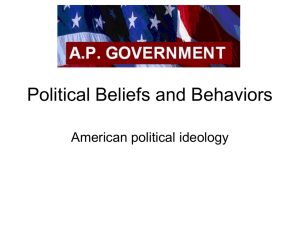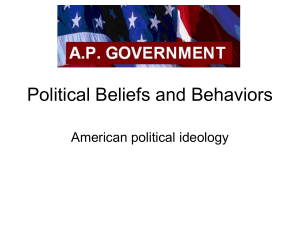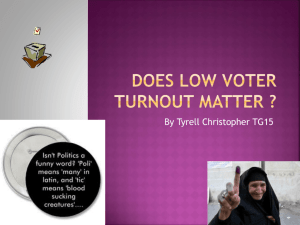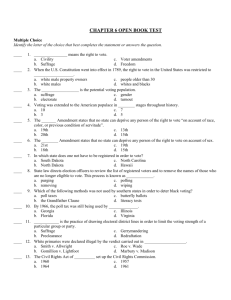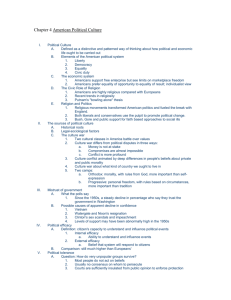Political Participation and Voter Behavior
advertisement
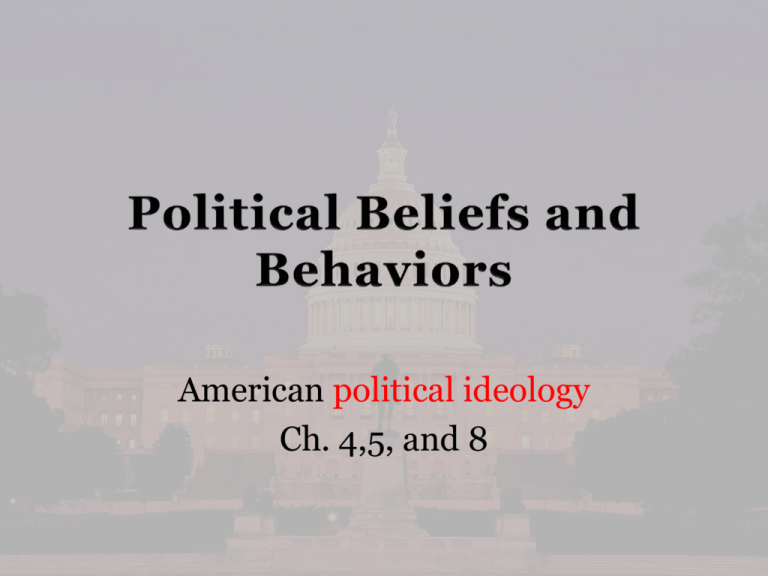
American political ideology Ch. 4,5, and 8 • Survey given to 10-14 year olds • One day the President was driving his car to a meeting. Because he was late, he was driving very fast. The police stopped the car. (Finish the story) • Different countries answer differently – England – Queen would be released – France – President would be excused – US – President would get a ticket like everyone else 2000 Election participation • 82% watched the campaign on television • 73% voted in the election • 34% tried to influence others how to vote • 10% put a sticker on their car • 9% gave money to help a campaign • 5% attended a political meeting • 3% worked for a party or candidate • Is this true? 73% of people vote? – No Different factors can tell us who votes 1. 2. 3. 4. 5. 6. Education – MOST IMPORTANT, more education=more voting Religious involvement Race and Ethnicity – Whites higher than minorities (might be economic based) Age – 18-24 is the lowest, and 45 and up is the highest Gender – men traditionally voted more, now it is more equal Two-party competition – more competitive elections have higher turnout Demography – characteristics of diff. groups Cross-cutting cleavages – individuals influenced by many factors across demographic groups Reinforcing cleavages – Reinforce a division between groups (Civil Rights) Socioeconomic status – Based on population, income, and education • Widely shared beliefs, values, and norms about how citizens relate to government • Elements of: 1. 2. 3. 4. 5. 6. 7. 8. Suffrage Social Capital Natural Rights Democratic Consensus Majority Rule Popular Sovereignty Nationalism Capitalism 1. 2. Lifting of property restrictions (1830) – “universal manhood suffrage” gave voting rights to all white males Suffrage for African-Americans (1863-1964) 1. 1865 - 15th Amendment – Voting Rights to all 2. 1954 - Brown v. Board – separate but equal is illegal, killed Jim Crow laws 3. 1964 24th Amendment – banned poll tax 4. 1965 – Voting Rights Act of 1965 – federal law prohibited (no literacy tests, fair elections etc.) 3. 4. Women’s Suffrage (1920) – 19th Amendment gave women the right to vote 18-21 year-olds (1971) – 26th Amendment, sparked by Vietnam • Process that influences and develops a person’s opinion • People in different social “groups” tend to share certain opinions: group identification I. The Family II. Gender and Age III.Race/Ethnicity IV. School V. Adult Socialization I. marriage, divorce, unemployment, new jobs, or moves to new locations. VI. Mass Media VII.Religion/Groups VIII.Social Class • #1 influence of political attitude • Very strong correlation for Political Party support Examples • More men support military • More women consider sexual harassment a serious problem • Since ’60s, women vote Democratic more than men, and vice versa • Gender Gap • Women tend to make less money than men • Glass Ceiling • Older Americans tend to vote more than younger Americans • 18-29 Year Olds Vote Turnout – 48% 2004 – 52% 2008 Example • Higher Education = more conservative or • College education = liberal views Conflicting results, not always a correlation • “Blue collar” (Laborer) typically Democrat • Men hold most blue collar jobs • “White collar” (Businessmen) typically Republican Relationship is becoming less clear Examples • African Americans (39 M) 13% – 90% Democrats • Hispanic Americans (46.9 M) 15% – tend to affiliate with Democrats, but less likely than African Americans • Asian Americans – less liberal than Hispanic Americans or African Americans, but still consistently vote Democrat • Minorities tend to vote more Democratic • White, more divided, fluctuates by election • Native Americans = Lower incomes than any other race in America Example • Protestants are more conservative on economic matters than Catholics or Jews • Jews (73%) tend to be more liberal on economic and social issues than Catholics or Protestants • Catholics tend to be more liberal on economic issues than they are on social issues (Catholics becoming more conservative) • Fundamentalists: Last twenty years these Conservative Christians have made an impact on the Republican Party (GOP) • Interest groups • Labor unions • Professional organizations • Trend of low voter turnout • 1964 – 69.3% (Voting Age Population %) • 1980 – 41.3% • 1984 – 60.9% • 1988 – 40.5% • 1992 – 55.2% • 1996 – 49.1% • 2000 – 51.3% • 2004 – 55.3% • 2008 – 56.8% • Registered Voter vs. Eligible Voter • Voter Registration – Increase in eligible voters has decreased turnout • Presidential elections higher than midterm • “Motor-Voter” (1993) – National Voter Registration Act – allowed people to register to vote while they get license • Difficulty of Absentee Voting (have to vote in person) • Increase in eligible voters has decreased turnout • Citizenship • Disfranchisement of certain groups (felons, the mentally incompetent) • Residency • Limited opportunities to vote (midweek, limited hours, single day) • Need to show identification (gov’t sanctioned ID cards in some states) • Closed primaries • Process of obtaining absentee ballots • Age: 18-29 year-olds (22%) • Ethnicity: Minorities (African American/Hispanic) lower than white • Education: 28% of adults who are high school graduates or have less education – 46% of all college graduates are regular voters • Religion: People who attend religious services (39%) tend to be regular voters compared to nonchurch goers (31%) • Socioeconomic Status: Upper class typically votes more than any other class. Based on 1. Party Identification 2. Candidates 3. Issues 1. Prospective voting – what a candidate may do in the future about an issue 2. Retrospective – President’s past performance on issues • Virginia 11th in Turnout (2008) • The South lowest in voter turnout – Mainly due to the fact that many African Americans are still unregistered • Northerners vote more than Southerners Other ways to participate besides voting Litigation Protest Contacting (e.g., media, public officials) Campaign work/ voter registration Advantages Numerical majority unnecessary; appeal to principle/law as opposed to opinion Bring public attention; sympathy; low cost; immediate response; expression of alienation Direct access to leaders; magnify representation; specify policy area in expression Contact with potential officials; multiply individual interest; training ground Campaign contributions Access; multiply force of individual preference Running for political office/ holding political Direct influence on political decisionoffice making; set policy agenda Political discussion to persuade others Bring others attention to issues toward action Membership in an overtly political Solidarity with others of like interests; organization magnifying effect (specific, obviously political or explained as political) • The distribution of individual attitudes about a particular issue, candidate, political institution, etc. 1. The Family 1. Most influential 2. The Schools: 1. Patriotism and customs 3. The Church 1. Shapes morality 4. Molders of Public Opinion 5. Mass Media 1. Educate the masses • Measures: – How intense the people are in beliefs – Real wants and needs of the people – Whether opinions are constant or changing – Polarization or consensus • Most accurate when the sample that is polled has a diverse population (aka universe) Representative sample – must mirror population you want answer about Random poll – give everyone an equal possibility of being sampled Wording – carefully worded to avoid confusion Planning – Must be properly planned Accurate Analysis Straw poll – poor polling technique; unofficial and hastily put together (Not a Good Poll) • Margin of Error – Range of % points in which the sample accurately reflects the population • + or – 3% points • Anything over 3-5% runs the risk of invalid conclusions • Polls are close but not 100% – 1948 Election • Dewey vs. Truman George Gallup Developed “Gallup Polls” • Started in 1932 • 1st “pollster” • Since 1936, agency has picked one general election result incorrect • Polling after voting • Coherent set of values and beliefs about public policy • Changes over time for all people • Liberal and conservative mean different things at different time periods 1. Ideologues – 12% of people connect their opinions to party lines 2. Group Benefits Voter – 42% of people connect their opinion to their “group”. (labor union, interest group, class, race) 3. Nature of the times voter – 24% of the people linked good or bad times to the party in control and vote the opposite (usually based on economics). 4. No Issue Content – 22% of the people could give no reason • Favors: Equal wealth, regulation of business, more federal spending on social programs, Prochoice, legislation for social justices for minorities • Opposes: Increase in defense spending, prayer in schools, tax breaks for upper class • Pessimistic about human nature believing that gov’t should be small. • Gov’t should focus on keeping order. • Favors: 1. Military spending, 2. free market economy, 3. prayer in school, 4. tax breaks on wealthy • Opposes: 1. Abortion 2. affirmative action 3. spending on social programs • Wealthy tends to be conservative but this is changing • • • • • Individual liberty Minimal government involvement Free Market Economy Neutrality Foreign Policy Absence of regulation on matters of morality, economy, and social life • Neo-Conservatives 1. Low tax, pro-economic growth 2. Ordered approach to domestic issues – Traditional values – pro-life, against gay marriage, support death penalty 3. Expansive foreign policy • • Counter global terrorism – “war on terror” expensive • Ownership of the economy by the government or a collective. • Characteristics – Economic and Social Equality – Gov’t ownership of land and production – Social Welfare – Classless Society • China, Vietnam, and Cuba • Most Americans tend to be more moderate or Centrists rather than Extremists 6% Example • East and West Coasts – more liberal • Mid-West – more conservative • Urban - liberal • South – 1870-1950s - Democrat “Solid South” but today they are primarily social conservatives • White Southerner always less liberal • Public trust of government has declined significantly in the last forty years

